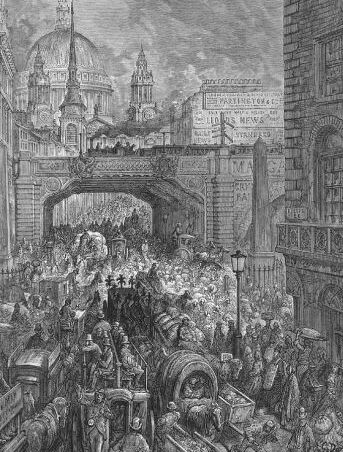|
Loud and Everlasting

London has always been characterised by the noise that is an aspect of its noisesomeness. It is part of its unnaturalness,
too, like the roaring some monstrous creature. But it is also a token of its energy and of its power.
From its earliest foundations London rang with the hammers of artisans and the cries of tradesmen; it produced more noise
than any other part of the country, and in certain quarters, like those of the smiths and barrel-makers, the clamour was almost
unsupportable. But there were other noises. In the early medieval city, the clatter of manufacturing trades and crafts would
have been accompanied by the sound of bells, among them secular bells, church bells, convent bells, th ebell of the curfew
and the bell of the watchman.
It might be surmised that the effect of the bells ended with the Reformation, when London ceased to be a notably pious
Catholic city, but all the evidence suggests that the citizens continued to be addicted to them. A German duke entered London
on the evening of 12th September 1602, and was astonished by the unique character of the city's sound.
' On arriving in London we heard a great ringing of bells in almost all the churches going on very late in the evening,
also on the following days untill 7 or 8 o'clock in the evening. We were informed that the young people do that for the sake
of exercise and amusement, and sometimes they lay considerable sums of money as a wager, who will pull a bell longest or ring
it in the most approved fashion. Parishes spend much money in harmoniously-sounding bells, that one preferred which has the
best bells. The old Queen is said to have been pleased very much by this exercise, considering it as a sign of the health
of the people.'
This Account is taken from The Acoustic World of Early Modern England by Bruce R. Smith., which offers an intimate
version of London's history. There is some suggestion here that the harmony of the bells is in some way intended to demonstrate
the harmony of the city. with the attendent 'health' of its citizens, but there is also an element of theatricality or bravura
intrinsic to London and Londoners. Indeed there is almost a kind of violence attaced to their liking of loud sound. Another
German traveller, of 1598, wrote that Londoners are ' vastly fond of great noises that fill the ear, such as the firing of
cannon, drums, and the ringing of bells, so that it is common for a number of them... to go to some belfry and ring the bells
for hours together for the sake of exercise'. A chaplain to the Venetian ambassador similarly reported that London boys made
bets ' who can make the parish bells be heard at the greatest distance'. To the element of display are added aggression and
competition.
|

